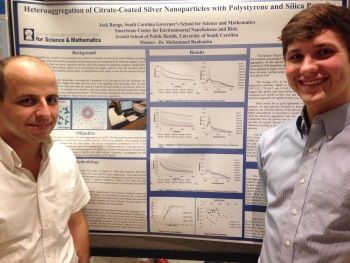High school student Jack Runge named semifinalist for research project conducted in Mohammed Baalousha's CENR lab
February 3, 2015

Runge (right) presents his research findings with mentor Baalousha in attendance.
The Center for Environmental Nanoscience and Risk (CENR) doesn't just conduct groundbreaking research on the effects of nanoparticles on the environment and public health. It also creates future scientists. In addition to providing postdoctoral and graduate assistantship opportunities, CENR faculty members have even included high school students in their pioneering research projects. In fact, high school student Jack Runge has just been named an Intel Science Talent Search 2015 semifinalist by Student Science based on the CENR research he participated in during the summer of 2014.
This particular competition is the nation's most prestigious pre-college science contest, with alumni going on to make exceptional contributions to science and holding Nobel Prize and National Medal of Science honors among their various accolades. Student Science selected only 300 semifinalists from more than 1,800 student submissions from across the U.S. Runge was the only semifinalist chosen from South Carolina.
In the CENR lab, Runge's project focused on the heteroaggregation of citrate-covered silver nanoparticles. His goal was to determine the stability of the nanoparticles when mixed with other particles in solution. The findings enabled Runge and the CENR team to make inferences about the fate and toxicity of the nanoparticles in the natural environment. Mohammed Baalousha, an assistant professor of environmental health sciences, guided Runge through the research project, providing background information, demonstrating the proper usage of lab instruments and teaching him how to analyze data.
"Dr. Baalousha was a phenomenal mentor, and I am grateful he gave me the opportunity to work with him," says Runge. "This experience has taught me many valuable laboratory techniques and solidified my interest in pursuing research as a career." Runge, who attends the South Carolina Governor's School for Science and Mathematics in Hartsville, hopes to be a researcher for a particle physics laboratory like Fermilab (Fermi National Accelerator Laboratory) or CERN (the French acronym for European Council for Nuclear Research). His interest in chemistry, particle physics and nanoparticles proved to be a great fit for working with Baalousha at CENR. The opportunity arose from his high school's SPRI initiative (Summer Program for Research Interns). SPRI connects students with mentors like Baalousha to conduct six-week research projects. "Runge demonstrated all the characteristics of a future scientist; he was intelligent, enthused and independent," says Baalousha.
Runge feels very fortunate to have worked with Baalousha who had a busy first year at the Arnold School. After moving to the United States from the United Kingdom to join the SmartState-funded CENR established by his University of Birmingham colleague, Jamie Lead, Baalousha also set up his research lab, acclimated himself to Carolina and expanded his family. He was also one of only 19 researchers in the world to be named an Emerging Investigator by the journal, Environmental Science: Process & Impact. Perhaps his mentoring efforts will lead to the next generation of emerging scientists as well.



_01.jpg)
_02.jpg)